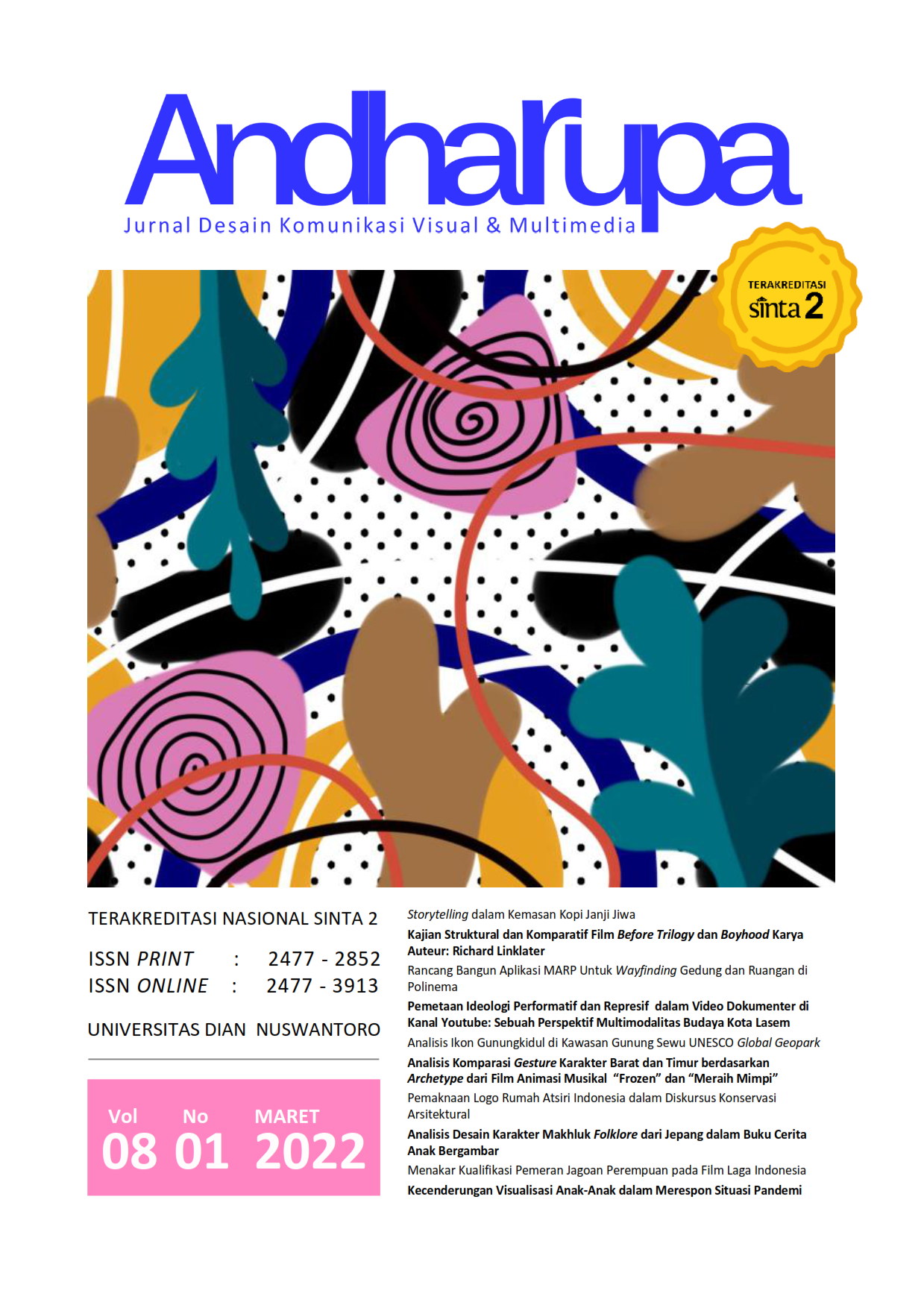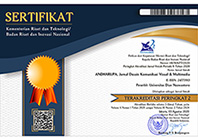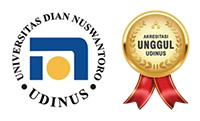PEMAKNAAN LOGO RUMAH ATSIRI INDONESIA DALAM DISKURSUS KONSERVASI ARSITEKTURAL
DOI:
https://doi.org/10.33633/andharupa.v8i01.4678Abstract
AbstrakLogo adalah bahasa visual yang merupakan abstraksi dan representasi dari banyak hal. Logo sering berisi kode atau tanda artistik yang hanya dimengerti oleh konvensi tertentu. Artikel ini bertujuan untuk memahami pemaknaan logo Rumah Atsiri Indonesia baik secara tekstual maupun kontekstual. Kajian tekstual membahas elemen-elemen pembentuk visual logo, seperti bentuk dasar, warna, dan teks. Pada pemaknaan kontekstual lebih mendalami perihal aspek kesejarahan yang melatarbelakangi pembentukan pemilihan logo itu sendiri. Penelitian ini menggunakan metode penelitian kualitatif dengan pendekatan studi kasus. Studi kasus dipilih agar data yang digali lebih spesifik dan mendalam melalui observasi, wawancara, dan studi literatur. Pada tahap analisis, data dari lapangan akan dielaborasi dengan data dari literatur seperti, buku, jurnal, dan penelusuran website. Hasil yang diperoleh dari penelitian ini antara lain, bentuk logo mengambil bentuk dasar fasad bangunan lama, dan pemilihan nama Rumah Atsiri Indonesia (kedua hal tersebut) merupakan abstraksi dari tindakan penerusan spirit cita-cita lama Pabrik Citronella 1963; warna pada logo adalah hasil perpaduan nuansa tanah dan cahaya matahari sebagai respon terhadap alam sekitar; pemilihan font memiliki kesamaan nuansa dengan gaya arsitektur bangunan lama dan sejarah keberadaan bangunan tersebut. Proses kreatif tersebut merupakan upaya untuk membentuk otentisitas Rumah Atsiri Indonesia melalui logo. Kata Kunci: logo, revitalisasi, Rumah Atsiri Indonesia, sejarah, semiotika AbstractThe Logo is one of polysemic sign language. It contains multiple subjective and objective meanings. This research will textually and contextually discuss the logo of Rumah Atsiri Indonesia. In textual area, the limit of this research will be on logo’s visual elements such as form, color, and body text. In contextual area, it will discuss historical reason behind the creative process of the logo. This research is qualitative study uses case study approaching. Case study is the best approach to lead researcher to a dept and specific information through observation, interview, and literature study. The datas both from field research and literature will be elaborated. Findings show that the main idea of the logo’s form is created from the roaster shape in old building’s façade. The name ‘Rumah Atsiri Indonesia’ and the fact that the logo’s form is taking from roaster’s design were derived by a willing of physically and historically conservation of the past 1963 company ‘Citronella Factory’; the color of the logo represents soil, sunlight and is a response to embrace the nature; typeface design follows the antiquity of old company and its historycal aspects. Thus, the discussion conclued that the logo of Rumah Atsiri Indonesia is symbol of its authenticity. Keywords: conservation, history, logo, Rumah Atsiri Indonesia, semioticReferences
Andang, B., Adiwibawa, P., & Prabowo, D. P. (2016). Karakter Fasad Bangunan Ikonik Kota. Jurnal Desain Komunikasi Visual dan Multimedia, February 2016, 23–32.
Architecture - Rumah Atsiri. (2020). https://rumahatsiri.com/architecture
Ardhiansyah, I., & Azizah, R. (2020). Pengukuran Greenship New Building Ver. 1.2 pada Bangunan Baru Rumah Atsiri Indonesia (Final Assessment). Sinektika: Jurnal Arsitektur, 15(2), 79–86.
Baker, B. P., Grant, J. A., & Malakar-Kuenen, R. (2018). Citronella & Citronella Oil Profile Citronella & Citronella Oil Profile Active Ingredient Eligible for Minimum Risk Pesticide Use. New York State IPM Program.
Barchiesi, M. A., Castellan, S., & Costa, R. (2018). In the eye of the beholder: Communicating CSR through color in packaging design. Journal of Marketing Communications, 24(7), 720–733.
Barthes, R. (1977). Image Music Text (S. Heath (Ed.)). Fontana Press.
Bossel, V., Geyskens, K., & Goukens, C. (2019). Facing a trend of brand logo simplicity: The impact of brand logo design on consumption. Food Quality and Preference, 71, 129–135.
Creswell, J. W. (2009). Research Design Qualitative, Quantitative, and Mixed Methods Approaches (hal. 13). Sage Publications.
Fakih, F. (2017). Strategies of Rent Seeking during The Sukarno Period: Foreigners and Corruption, 1950-1965. Lembaran Sejarah, 13(April), 91–108.
Foroudi, P., Melewar, T. C., & Gupta, S. (2017). Corporate Logo: History, Definition, and Components. International Studies of Management and Organization, 47(2), 176–196.
Gibson, J. (2006a). Production-Sharing. Bulletin of Indonesian Economic Studies, 2(3), 52–75.
Gibson, J. (2006b). Production-Sharing: Part II. Bulletin of Indonesian Economic Studies, 2(4), 75–100.
Graham, D. (2019). Flower power new ecotourism with a complex past - Destinations - The Jakarta Post. https://www.thejakartapost.com/travel/2019/01/15/flower-power-new-ecotourism-with-a-complex-past.html
Hasil Pencarian - KBBI Daring. (n.d.). Diambil 22 Mei 2021, dari https://kbbi.kemdikbud.go.id/entri/asiri
Lestari, D. E., & Syafiq, M. (2017). Proses Kreatif Seniman Rupa Proses Kreatif Seniman Rupa. In Character: Jurnal Penelitian Psikologi. (Vol. 4, Nomor 1).
Marianto, M. D. (2019). Seni & Daya Hidup dalam Perspektif Quantum. Scritto Books dan BP ISI Yogyakarta.
Mukaromah, M. (2016). Semiotika Kemasan Produk Susu Rasa Coklat dan Stroberi pada Merek Indomilk Kids Dan Boneeto. ANDHARUPA: Jurnal Desain Komunikasi Visual & Multimedia, 2(01), 45–55.
Park, C. W., Eisingerich, A. B., Pol, G., & Park, J. W. (2013). The role of brand logos in firm performance. Journal of Business Research, 66(2), 180–187.
Purwanto, A., Octavia2, E. R., & Adi, S. P. (2021). Wayang Godhong sebagai Media Edukasi Cinta Budaya dan Alam Sejak Usia Dini. Jurnal Desain Komunikasi Visual dan Multimedia, 07(01 Februari), 200–208.
Research, S. (2018). 10 Arsitek Indonesia Pilihan Sarasvati - Page 7 of 11 - Sarasvati. https://sarasvati.co.id/news/architecture/01/arsitek-indonesia-pilihan/7/
Samara, T. (2018). Letterforms Type Face Design from Past to Future (1 ed.). Rockport Publishers.
Senasaputro, B. B. (2018). Kajian Arsitektur Regionalisme; Sebagai Wacana Menuju Arsitektur Tanggap Lingkungan Berkelanjutan. ULTIMART Jurnal Komunikasi Visual, 10(2), 73–84.
Silaban, N. W., Nainggolan, J. L. F., & Pane, I. F. (2018). Kajian Pengaruh Kekuasaan Pemerintah Era Poskolonial terhadap Arsitektur di Medan. Jurnal Koridor, 09(02), 345–353.
Sugiyono. (2018). Metode Penelitian Kombinasi (Sutopo (Ed.); 10 ed.). Alfabeta.
Sumartono. (2017). Metodologi Penelitian Kualitatif Seni Rupa dan Desain. Pusat Studi Reka Rancang Visual dan Lingkungan.
Sunaryo, & Sudiro, A. (2017). The Impact of Brand Awareness on Purchase Decision: Mediating Effect of Halal logo and Religious beliefs on Halal Food in Malang Indonesia. Sydney International Business Research Conference, 54.
Suwarni, S., Siti Khadijah, U. L., & Rachmat, H. (2021). The Development Strategy Of Educational Tourism At Rumah Atsiri Indonesia In The Era Of Adapting To A New Normal. Sosiohumaniora, 23(1), 97.
Swani, K., Milne, G. R., & Miller, E. G. (2021). Social media services branding: The use of corporate brand names. Journal of Business Research, 125, 785–797.
Van Grinsven, B., & Das, E. (2014). Journal of Marketing Communications Logo design in marketing communications: Brand logo complexity moderates exposure effects on brand recognition and brand attitude. Journal of Marketing Communications, 22(3), 256–270.
Wang, K., & Nickerson, J. V. (2017). A literature review on individual creativity support systems. In Computers in Human Behavior (Vol. 74, hal. 139–151). Elsevier Ltd.
Wang, Z., Duff, B. R. L., & Clayton, R. B. (2018). Establishing a Factor Model for Aesthetic Preference for Visual Complexity of Brand Logo. Journal of Current Issues & Research in Advertising, 39(1), 83–100.
Wirasari, I., Evipani, T., & Karo, B. R. (2018). Kajian Gaya Bahasa Iklan Antangin Fit Pada Media Sosial. Demandia, Jurnal Desain Komunikasi Visual, 03(02).
Downloads
Published
Issue
Section
License
Copyright (c) 2022 ANDHARUPA: Jurnal Desain Komunikasi Visual & Multimedia

This work is licensed under a Creative Commons Attribution 4.0 International License.
Authors who publish with this journal agree to the following terms:
- Authors retain copyright and grant the journal right of first publication with the work simultaneously licensed under a Creative Commons Attribution License that allows others to share the work with an acknowledgment of the work's authorship and initial publication in this journal.
- Authors are able to enter into separate, additional contractual arrangements for the non-exclusive distribution of the journal's published version of the work (e.g., post it to an institutional repository or publish it in a book), with an acknowledgment of its initial publication in this journal.
- Authors are permitted and encouraged to post their work online (e.g., in institutional repositories or on their website) prior to and during the submission process, as it can lead to productive exchanges, as well as earlier and greater citation of published work (See The Effect of Open Access).















